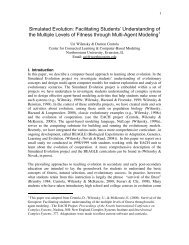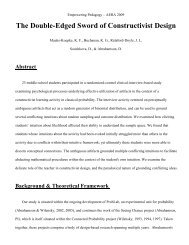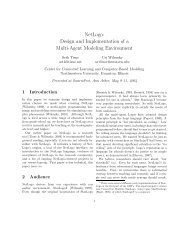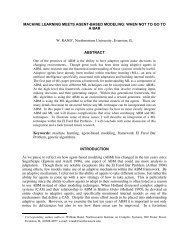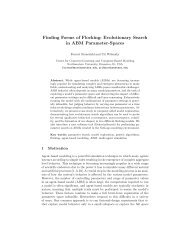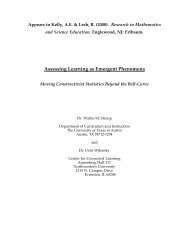Design Guidelines for Agent Based Model Visualization
Design Guidelines for Agent Based Model Visualization
Design Guidelines for Agent Based Model Visualization
You also want an ePaper? Increase the reach of your titles
YUMPU automatically turns print PDFs into web optimized ePapers that Google loves.
<strong>Design</strong> <strong>Guidelines</strong> <strong>for</strong> <strong>Agent</strong> <strong>Based</strong> <strong>Model</strong> <strong>Visualization</strong><br />
9.7<br />
9.8<br />
9.9<br />
10.1<br />
10.2<br />
10.3<br />
intermediate agent positions between two locations. A good rule of thumb is to move the object at<br />
most 1/3 of its size between each frame (Ware 2002). This criterion does not apply if the object is<br />
very small (such as 1 pixel wide) or very large. Motion blur probably requires accessing lower level<br />
graphics, which are usually inaccessible in a high level toolkit.<br />
Irregular frame rate is due to the changing computational load at each iteration. This unpredictable<br />
rate can confuse and frustrate the viewer. If the computational load fluctuates due to a changing<br />
number of agents, the model author can try to stabilize updates by intentionally slowing down the<br />
model to the lowest possible frame rate.<br />
Ideally, agents should be bounded with physical restrictions (viscosity, inertia, etc ..) in such a way<br />
that agents change their position or appearance in a smooth predictable manner. In the future, these<br />
physical restrictions and other artifacts such as the previously mentioned (temporal aliasing and<br />
regular frame rate) should be automatically handled by toolkits. New developments in hardware and<br />
software will implement this functionality. For example in hardware, multi processors systems or<br />
GPUs (Graphical Processor Unit) can be solely dedicated to graphics and per<strong>for</strong>m the necessary<br />
computations. Additionally in software, new animation frameworks are managing individual elements<br />
on a frame-by-frame basis. In these new frameworks, a smooth animation can be created by<br />
specifying the start and end position -- the libraries calculate the intermediate locations <strong>for</strong> a smooth<br />
transition.<br />
There are however many visualization aspects that cannot be automated, <strong>for</strong> example facilitating a<br />
particular user such as tracking, estimation or segregation. Additionally, the model author should<br />
prevent visual interferences such as those discussed in the next section.<br />
Cognitive Science <strong>Visualization</strong> Principles<br />
Cognitive Science has elucidated many principles of effective, as well as misleading, visualizations.<br />
Here we focus on two cognitive phenomena the user should be concerned with when creating an<br />
ABM visualization: pre-attentive visual processing and visual interference. Creating visualizations<br />
that can be pre-attentively processed and are free of visual interference enables a viewer to per<strong>for</strong>m<br />
fast, automatic and spatially parallel operations to understand the visualization. Pre-attentive<br />
operations can detect visual features such as intensity, hue, and orientation and assist in tasks such as<br />
boundary detection and high-speed target tracking (Healey 1995; 1996). However, pre-attentive<br />
operations can be impeded by visual interference. For example, visual interference can occur when a<br />
chosen visual variable conflicts with another visual variable. Another example of visual interference<br />
occurs when a selected visual variable is so dominant that it makes the other visual variables<br />
imperceptible.<br />
Pre-attentive Visual Processing<br />
Pre-attentive visual processing enables the fast and scalable perception of the features of a<br />
visualization. It allows the viewer to process animations containing a large number of graphic<br />
elements, as is often the case in ABM animations. Pre-attentive visual tasks can usually be<br />
accomplished in less than a quarter of a second (Ware 2004), independent of the number of graphic<br />
elements involved, which allows the viewer to process high-speed, in<strong>for</strong>mation-rich ABM animations.<br />
In order to construct an ABM visualization that can be processed pre-attentively, the modeler must<br />
pinpoint the visual tasks him requires from the viewers. By doing so, the modeler can select the<br />
optimal visual features to accomplish the task and construct a visualization that allows the viewer to<br />
http://jasss.soc.surrey.ac.uk/12/2/1.html<br />
11/20/09 3:30 PM<br />
Page 18 of 32







